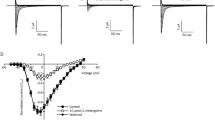Abstract
Intracellular recording in the guinea-pig brainstem slice has demonstrated that high molecular weight alcohols block the low threshold calcium channel (LTCC) in the inferior olive (IO). These alcohols thus provide a tool for understanding the function of the pacemaking cellular networks of the olivo-cerebellar system, since the LTCC has been implicated in the oscillatory behavior of these neurons. Aspects of normal and pathological tremor are also believed to be mediated by these circuits, and thus development of effective ways of blocking the LTCC in vivo may eventually lead to novel treatments for essential tremor. The present experiments evaluated the effectiveness of the isomers of octanol in decreasing harmaline-induced tremor in vivo in the rat. Harmaline was used in this study because its tremorgenic action is mediated at the level of IO; octanol was found to be a potent antagonist of harmaline-induced tremor. Significant differences between the isomers further suggested conformational differences. This, taken in conjunction with the lack of effect of octanol in both IO lesioned rats and oxotremorine-induced tremor, implied that the action of the alcohol may be mediated at a specific binding site. These findings thus support the conclusions that the antagonism of harmaline-induced tremor by octanol occurs in the IO, and, in view of the previously reported in vitro data, that octanol may be an effective blocker of the LTCC in vivo.
Similar content being viewed by others

References
Bernado LS, Foster RE (1986) Oscillatory behavior in inferior olive neurons: mechanism, modulation, cell aggregates. Brain Res Bull 17:773–784
Brimblecombe RW, Pinder RM (1972) Tremors and tremorogenic agents. Scientechnica, Bristol
Burt DR (1985) Criteria for receptor identification. In: Yamamura HI, Enna SJ, Kuhar MJ (eds) Neurotransmitter receptor binding, 2nd edn. Raven Press, New York, pp 41–60
Burt DR, Creese I, Snyder SH (1976) Properties of [3H]haloperidol and [3H]dopamine binding associated with dopamine receptors in calf brain membranes. Mol Pharmacol 12:800–812
Calzetti S, Findley LJ, Perucca E, Richens A (1983) The response of essential tremor to propranolol: evaluation of clinical variables governing its efficacy on prolonged administration. J Neurol Neurosurg Psychiatry 45:393–398
de Montigny C, Lamarre Y (1973) Rhythmic activity induced by harmaline in the olivo-cerebellar-bulbar system of the cat. Brain Res 53:81–95
Desclin JC, Escubi J (1974) Effects of 3-acetylpyridine on the central nervous system of the rat, as demonstrated by silver methods. Brain Res 77:349–364
Findley LJ, Koller WC (1987) Essential tremor: a review. Neurology 37:1194–1197
Findley LJ, Cleeves L, Calzetti S (1985) Primidone in essential tremor of the hands and head: a double-blind controlled clinical study. J Neurol Neurosurg Psychiatry 48:911–915
Finney DJ (1978) Statistical method in biological assay, 3rd edn. MacMillan, London, pp 46–47
Hara S (1953) Pharmacological studies in the functions of the extrapyramidal system. Jpn J Pharmacol 2:127–138
Koller W, Biary N, Cone S (1986) Disability in essential tremor: effect of treatment. Neurology 36:1001–1004
Lamarre Y (1979) Cerebro-cerebellar mechanisms involved in experimental tremor. In: Massion J, Sasaki K (eds) Developments in neuroscience, vol 6. Elsevier/North Holland, Amsterdam New York, pp 249–259
Lamarre Y (1984) Animal models of physiological, essential and parkinsonian-like tremors. In: Findley LJ, Capildeo R (eds) Movement disorders: tremor. MacMillan, London, pp 183–194
Llinás R (1984) Rebound excitation as the physiological basis for tremor: A biophysical study of the oscillatory properties of mammalian central neuronsin vitro. In: Findley LJ, Capildeo R (eds) Movement disorders: tremor. MacMillan, London, pp 165–182
Llinás R, Volkind RA (1973) The olivo-cerebellar system: functional properties as revealed by harmaline-induced tremor. Exp Brain Res 18:69–87
Llinás R, Walton K, Hillman DE, Sotelo C (1975) Inferior olive: its role in motor learning. Science 190:1230–1231
Llinás R, Yarom Y (1981) Properties and distribution of ionic conductances generating electroresponsiveness of mammalian inferior olivary neuronesin vitro. J Physiol 315:569–584
Llinás R, Yarom Y (1986a) Oscillatory properties of guinea-pig inferior olivary neurones and their pharmacological modulation: an in vitro study. J Physiol 376:163–182
Llinás R, Yarom Y (1986b) Specific blockade of the low threshold calcium channel by high molecular weight alcohols. Soc Neurosci 12:174 (Abstr)
Marsden CD (1984) Origins of normal and pathological tremor. In: Findley LJ, Capildeo R (eds) Movement disorders tremor. MacMillan, London, pp 37–84
Murray TJ (1972) Treatment of essential tremor with propranolol. Can Med Assoc J 107:984–986
Perucca E, Pickles H, Richens A (1981) Effect of atenolol, metoprolol and propranolol on isoproterenol-induced tremor and tachycardia in normal subjects. Clin Pharmacol Ther 29:425–433
Pranzatelli MR, Snodgrass SR (1987) Harmala alkaloids and related β-carbolines: a myoclonic model and antimyoclonic drugs. Exp Neurol 96:703–719
Stephenson R, Stuart J (1986) Mutual binary solubilities: wateralcohols and water-esters. J Chem Eng Data 31:56–70
Yarom Y, Llinás R (1987) Long-term modifiability of anomolous and delayed rectification in guinea pig inferior olivary neurons. J Neurosci 7:1166–1177
Author information
Authors and Affiliations
Rights and permissions
About this article
Cite this article
Sinton, C.M., Krosser, B.I., Walton, K.D. et al. The effectiveness of different isomers of octanol as blockers of harmaline-induced tremor. Pflugers Arch. 414, 31–36 (1989). https://doi.org/10.1007/BF00585623
Received:
Revised:
Accepted:
Issue Date:
DOI: https://doi.org/10.1007/BF00585623



